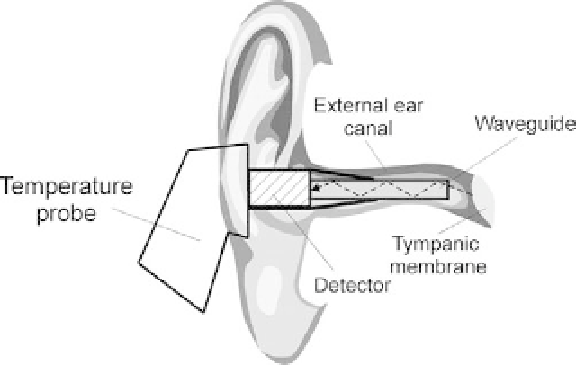Biomedical Engineering Reference
In-Depth Information
EXAMPLE PROBLEM 10.13
Find the Seebeck coefficient for the Chromel/Alumel thermocouple at a temperature of 500
C.
Solution
Using Eq. (10.18) with the coefficients given in Example Problem 10.12 yields
V/
C.
a
57
m
Tympanic Thermometer
Noncontact thermometers measure the temperature of the ear canal near the tympanic
membrane, which is known to track the core temperature by about 0.5-1.0
C. Basically,
as shown in Figure 10.24, infrared radiation from the tympanic membrane is channeled to
a heat-sensitive detector through a metal waveguide that has a gold-plated inner surface
for better reflectivity. The detector, which is either a thermopile or a pyroelectric sensor that
converts heat flow into an electric current, is normally maintained at a constant temperature
environment to minimize inaccuracies due to fluctuation in ambient temperature. A dispos-
able speculum is used on the probe to protect patients from cross-contamination.
Temporal Artery Thermometer
A noninvasive scanning thermometer was developed by Exergen Corporation as an
alternative to the tympanic thermometer for measuring core body temperature, essentially
eliminating the discomfort caused by a mouth, ear, or rectal thermometer (Figure 10.25).
The measurement is based on scanning the area above the temporal artery using an IR
detector similar to the sensor used in the tympanic thermometer. The superficial temporal
artery extends directly from the external carotid artery and travels in front of the ear. Ana-
tomically, it is lying approximately 1 mm below the skin, readily accessible, and maintains
good blood perfusion. Assuming zero thermal loss to the environment, the skin surface
over the temporal artery area would be at the same temperature as the arterial blood in
the aorta, which is essentially equal to core body temperature. Since ambient temperature
FIGURE 10.24
Noncontact-type infrared ear thermometer.


